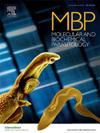The role of complement system in a gerbil model of cutaneous leishmaniasis
IF 1.5
4区 医学
Q4 BIOCHEMISTRY & MOLECULAR BIOLOGY
引用次数: 0
Abstract
Leishmania species are intracellular protozoans responsible for causing both cutaneous and visceral infections. In recent years, the prevalence of leishmaniasis, a systemic and chronic disease, has been on the rise. Complement pathway mechanisms, part of the immune response of host organisms against Leishmania species, have not been fully revealed in leishmaniasis, which is very important for public health. This study aimed to explore the role of the complement system, an integral part of the immune response to Leishmania infections, in gerbil (Meriones unguiculatus) models of cutaneous leishmaniasis. This was achieved by assessing the expression levels of complement system genes (MBL-1, MBL-2, C2, and C3) and quantifying the protein levels of MBL-1, C2, and C3. Additionally, the study aimed to conduct biochemical tests, specifically measuring GSH and MDA levels, to detect oxidative stress in response to infection in gerbils. Finally, hematological analyses were performed to evaluate leukocyte counts in the blood. The expression of complement system genes and some complement system proteins were significantly increased in infected gerbils. Oxidative stress was evident, as indicated by reduced GSH levels and increased MDA levels. Additionally, a significant rise in leukocyte counts was observed as a consequence of the infection. The study concluded that complement system pathways are activated in cutaneous leishmaniasis infections. It was also determined that a thorough evaluation of genomic, proteomic, and immunopathological mechanisms is essential for understanding the pathogenesis of the disease.
补体系统在沙鼠皮肤利什曼病模型中的作用。
利什曼原虫属细胞内原生动物,可引起皮肤和内脏感染。近年来,利什曼病(一种全身性慢性疾病)的流行率一直在上升。补体途径机制是宿主机体对利什曼原虫免疫反应的一部分,在利什曼病中尚未完全揭示,这对公共卫生具有重要意义。本研究旨在探讨补体系统在沙鼠皮肤利什曼病模型中的作用,补体系统是对利什曼感染免疫反应的一个组成部分。这是通过评估补体系统基因(MBL-1、MBL-2、C2和C3)的表达水平和量化MBL-1、C2和C3的蛋白水平来实现的。此外,该研究旨在进行生化测试,特别是测量谷胱甘肽和丙二醛水平,以检测沙鼠对感染的氧化应激反应。最后,进行血液学分析以评估血液中的白细胞计数。感染沙鼠体内补体系统基因及部分补体系统蛋白的表达显著升高。氧化应激明显,GSH水平降低,MDA水平升高。此外,白细胞计数显著上升被观察到作为感染的结果。该研究得出结论,补体系统途径在皮肤利什曼病感染中被激活。研究人员还认为,全面评估基因组学、蛋白质组学和免疫病理机制对于了解该病的发病机制至关重要。
本文章由计算机程序翻译,如有差异,请以英文原文为准。
求助全文
约1分钟内获得全文
求助全文
来源期刊
CiteScore
2.90
自引率
0.00%
发文量
51
审稿时长
63 days
期刊介绍:
The journal provides a medium for rapid publication of investigations of the molecular biology and biochemistry of parasitic protozoa and helminths and their interactions with both the definitive and intermediate host. The main subject areas covered are:
• the structure, biosynthesis, degradation, properties and function of DNA, RNA, proteins, lipids, carbohydrates and small molecular-weight substances
• intermediary metabolism and bioenergetics
• drug target characterization and the mode of action of antiparasitic drugs
• molecular and biochemical aspects of membrane structure and function
• host-parasite relationships that focus on the parasite, particularly as related to specific parasite molecules.
• analysis of genes and genome structure, function and expression
• analysis of variation in parasite populations relevant to genetic exchange, pathogenesis, drug and vaccine target characterization, and drug resistance.
• parasite protein trafficking, organelle biogenesis, and cellular structure especially with reference to the roles of specific molecules
• parasite programmed cell death, development, and cell division at the molecular level.

 求助内容:
求助内容: 应助结果提醒方式:
应助结果提醒方式:


